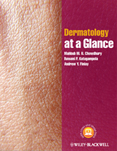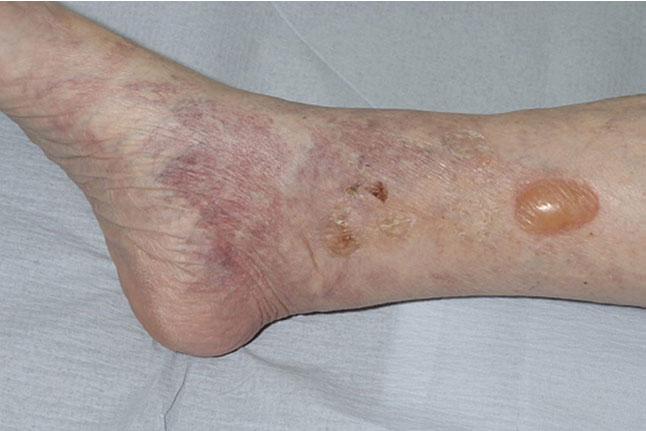-
(a) What is the most likely diagnosis?
Show Answer
Bullous pemphigoid. The tense blisters, history of itching and the patient’s age makes this the most likely diagnosis.
-
(b) Where else would you examine this patient?
Show Answer
Involvement of mucosal surfaces such as the oral mucosa, genitalia, conjunctiva for blisters and/or erosions.
-
(c) What is the underlying aetiology of this condition?
Show Answer
Development of IgG auto-antibodies to skin basement membrane antigens BP180 or BP230 resulting in cleavage of the skin at the dermo-epidermal junction leading to subepidermal blisters.
-
(d) What specific investigations would you undertake in this patient?
Show Answer
Blood test for serum pemphigoid antibodies.
Skin biopsies: (a) from lesional skin for histology with haematoxylin and eosinophil staining which will demonstrate subepidermal blisters; and (b) peri-lesional skin for direct immunofluorescence which will demonstrate linear IgG at the basement membrane.
-
(e) What is your differential diagnosis of a blistering rash?
Show Answer
Insect bites, drug-induced, infection (e.g. bullous impetigo), other autoimmune blistering diseases (e.g. dermatitis herpetiformis, pemphigus vulgaris).
-
(f) How would you treat this patient?
Show Answer
Given the widespread nature of this patient’s bullous pemphigoid, he should be treated with a reducing course of oral prednisolone starting at about 30 mg/day in combination with an oral immunosuppressant such as azathioprine or mycophenolate mofetil. If he had more limited disease, a trial of topical super-potent corticosteroid such as 0.05% clobetasol proprionate could be tried prior to considering systemic treatment.
-
(g) What precautions need to be taken with regards to the use of systemic treatment in this patient?
Show Answer
As this patient may be on a long period of high-dose oral steroids, he requires osteoporosis prophylaxis and monitoring for steroid-induced hypertension and diabetes. In addition, use of oral immunosuppressants such as azathioprine or mycophenolate mofetil requires regular monitoring of his blood count, renal and liver function.




